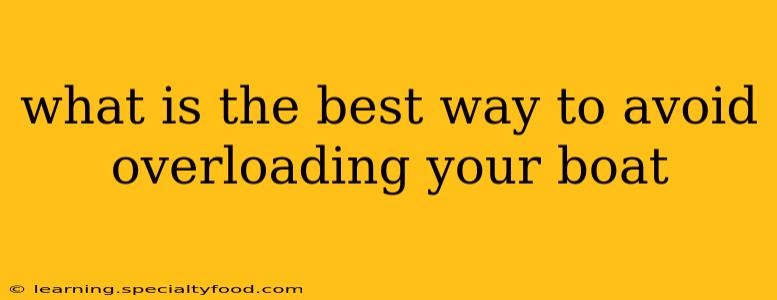Avoiding Boat Overload: A Comprehensive Guide to Safe Boating
Overloading a boat is a serious safety hazard that can lead to capsizing, swamping, and even fatalities. Understanding your boat's capacity and adhering to safe loading practices is crucial for every boater. This guide provides a comprehensive overview of how to avoid overloading your boat, addressing common questions and concerns.
What is the maximum weight capacity of my boat?
This is arguably the most important question! Your boat's maximum weight capacity, often called its "maximum load capacity" or "carrying capacity," is clearly stated on a plate affixed to the boat itself, usually near the helm or transom. This plate provides crucial information, including the maximum weight of passengers, gear, and fuel. Never exceed this weight limit. If you can't locate this plate, consult your boat's owner's manual or contact the manufacturer directly.
How do I calculate the weight of passengers and gear?
Accurately estimating the weight of passengers and gear is vital. Assume an average weight of 150-175 pounds per adult passenger, and adjust accordingly for children. For gear, weigh each significant item (coolers, anchors, fishing tackle, etc.) on a scale, or use estimated weights found online for common items. Remember to account for the weight of fuel in your tanks – this adds considerable weight, particularly in larger boats.
What are some common mistakes boaters make that lead to overloading?
Many overloading incidents stem from miscalculating passenger weight, overlooking gear weight, or neglecting the effects of added weight from water accumulation (rain or waves splashing into the boat). Another common mistake is assuming a boat can handle more weight simply because it seems stable with fewer people on board. This is dangerous; added weight can drastically change a boat's stability and dramatically increase the risk of capsizing.
How much weight should I allocate for gear?
The weight allocated to gear should be considered alongside the number of passengers and the boat's maximum weight capacity. It's generally recommended to leave a substantial safety margin; don't fill your boat to its absolute limit. This safety margin ensures the boat remains stable even if unexpected weight is added (e.g., unexpected rain, unexpectedly large catch of fish).
What are the signs of an overloaded boat?
An overloaded boat will exhibit several warning signs. These include:
- Low freeboard: The distance between the waterline and the gunwale (top edge of the hull) will be significantly reduced.
- Difficulty in planing (for powerboats): The boat may struggle to reach plane or maintain its speed.
- Slow response to steering: The boat may feel sluggish and unresponsive to steering inputs.
- Excessive leaning: The boat might list noticeably to one side, especially when turning.
- Water entering the boat: Overloading can increase the risk of waves washing over the deck.
If you observe any of these signs, immediately reduce the weight onboard.
What are the legal consequences of overloading a boat?
Overloading a boat is illegal in most jurisdictions and can result in hefty fines. Moreover, it's crucial to remember that the safety and lives of those on board should always be the utmost priority, far exceeding any concern about legal penalties.
How can I distribute weight evenly in my boat?
Even weight distribution is key to maintaining stability. Heavy items should be positioned low and centrally in the boat. Distribute passengers evenly throughout the boat, avoiding concentration in one area.
By understanding your boat's capacity, accurately estimating weights, and carefully distributing weight, you can significantly reduce the risk of overloading and ensure a safe and enjoyable boating experience. Remember, safety should always be your top priority on the water.
